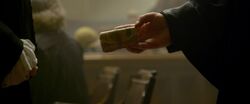
- "No doubt you've discovered that loyalty is no longer the currency of the realm, as your father believes."
"Then what is?"
"I'm afraid currency, is the currency of the realm." - ―Cutler Beckett and Elizabeth Swann
A currency was a standardization of money (or monies) in any form, in use or circulation as a medium of exchange, for example coins and banknotes. Money was any item or verifiable record that was generally accepted as payment for goods and services and repayment of debts, such as taxes, in a particular country. As a more general definition, a currency is a system of money in common use within a specific environment over time, especially for people in a nation. Currencies may be traded between nations in foreign exchange markets, which determine the relative values of the different currencies. Currencies in this sense were either chosen by users or decreed by governments, and each type has limited boundaries of acceptance.
History
During the Age of Piracy, a coin's worth was measured by the weight of the precious metal rather than its denomination, and Spanish coins such as gold doubloons and silver pieces of eight were the most common in the Caribbean. The peso, also known as the ocho reales, or piece of eight, was a heavy silver coin, and, except for the doubloon, the most valuable currency in the New World.[1] According to legends, in his conquest against the Aztec Empire, Hernán Cortés was given a stone chest, filled with 882 pieces of Aztec gold as blood money, which instead fulled his greed.[2] The going price these days for a male slave in his prime would run, say, between one hundred and two hundred pieces of eight. In pounds sterling, the currency the East India Trading Company used, that would equal between sixty and one hundred and twenty pounds.[3]
During the search for the Dead Man's Chest, Lord Cutler Beckett told Elizabeth Swann that her father, Governor Weatherby Swann, believed that loyalty was the currency of the realm. However, Beckett added that it was currency, rather than loyalty, was the currency of the realm.[4] Years later, during the quest for the Fountain of Youth in 1750, when Captain Jack Sparrow's first mate Joshamee Gibbs found himself condemned to death by hanging while being put on trial as "Jack Sparrow" in a case of mistaken identity at the Old Bailey, a bundle of currency exchanged hands from an official to the bailiff, one pound banknotes serving as a bribe as Sparrow himself sauntered into the courtroom as the "Right Honorable Justice Smith" to rescue Gibbs from an angry mob in London, England.[5]

About one year later, by the search for the Trident of Poseidon, the Royal Bank of Saint Martin opened, only for a down-on-his-luck Captain Jack Sparrow to be seen asleep in the bank's vault, surrounded with all forms of currency. As the vault was dragged by Sparrow's motley crew of pirates in a bank heist, gold coins being tossed helter-skelter from the open vault and the hole in the building. Frantically, Jack tried to grab as many as he could, but without success, because at the same time, he was being dragged too. At the time of Sparrow's robbery, the astronomer Carina Smyth attempted to buy a chronometer from the scientist George Swift for a few gold coins, but the scared scientist pulled out a pistol and called her a witch. After the robbery, only one coin remained in the vault, which was promptly taken by Sparrow without his crew noticing.[6]
Behind the scenes
Although currency, such as coins, has appeared since Walt Disney's Pirates of the Caribbean,[7] the term "money" was first used through "blood money" in the 2003 film Pirates of the Caribbean: The Curse of the Black Pearl.[8] The term "currency" is first mentioned in the 2006 film Pirates of the Caribbean: Dead Man's Chest.[4] For the 2011 film Pirates of the Caribbean: On Stranger Tides,[5] the term "monies" was used in a backstory for Blackbeard and Angelica found in the Disney Second Screen feature.[9]
In Ted Elliott and Terry Rossio's screenplay for On Stranger Tides, an "Official" whispers into the ear of the Bailiff, who nods as a bundle of currency exchanges hands prior to announcing "Justice Smith" the trial against Joshamee Gibbs, who was mistaken as Captain Jack Sparrow.[10] While the type of currency was never identified, one pound banknotes can be seen in the film.[5]
In Terry Rossio's 2012 screenplay draft for Dead Men Tell No Tales, during the final battle, Jack Sparrow hallucinated several events from his past, until he swam into a huge British flag, becoming tangled in it and coming face to face with Cutler Beckett, who tells him "Currency is the currency of the realm".[11]
Appearances
- Walt Disney's Pirates of the Caribbean (First appearance)
- The Price of Freedom
- Pirates of the Caribbean: The Curse of the Black Pearl (First identified as blood money)
- Pirates of the Caribbean: Dead Man's Chest (Mentioned only)
- Pirates of the Caribbean: On Stranger Tides
- Pirates of the Caribbean: Dead Men Tell No Tales
Sources
- Disney Second Screen: Pirates of the Caribbean: On Stranger Tides (First identified as monies)
External links
Notes and references
- ↑ The Price of Freedom, Chapter Ten: Revelations
- ↑ Pirates of the Caribbean: The Curse of the Black Pearl
- ↑ The Price of Freedom, Chapter Twelve: Shabako
- ↑ 4.0 4.1 Pirates of the Caribbean: Dead Man's Chest
- ↑ 5.0 5.1 5.2 Pirates of the Caribbean: On Stranger Tides
- ↑ Pirates of the Caribbean: Dead Men Tell No Tales
- ↑ Disneyland: From the Pirates of the Caribbean to the World of Tomorrow
- ↑ Pirates of the Caribbean: The Curse of the Black Pearl
- ↑ Disney Second Screen: Pirates of the Caribbean: On Stranger Tides
- ↑ Wordplayer.com: PIRATES OF THE CARIBBEAN: ON STRANGER TIDES by Ted Elliott & Terry Rossio
- ↑ Wordplayer.com: PIRATES OF THE CARIBBEAN: DEAD MEN TELL NO TALES by Terry Rossio